For my SUTs to phono-stages and from there to my preamps, I use Mogami 2549. I solder one conductor to the center terminal of the RCA and the other to the shell terminal. The shield is connected at one end only to the shell terminal and well insulated form making contact at the other. Noticeably quieter than Blue Jeans cables I was using before. Maybe at some point I'll try the star-quad Mogami.
For phono I use something else other than star-quad, particularly since the DIN connectors are so small.
a StarQuad has a lot more capacitance than a coax. This has to be taken into consideration with a MM cartridge.
I recently developed a 36pF/m phono cable utilising a 16-core braided conductor geometry.
I'm a firm advocate for the CMRR principle which a braided wire geometry facilitates admirably and which provides a better EMI/RFI shield than any built-in cable shield.
I also observed significant and audible differences between SPC, Cu and hybrid SPC/Cu configurations.
The most important thing to remember with phono cables is that shorter is always better as is the lowest capacitance possible in order to create headroom for the higher frequency range in the rest of the signal path.
DIN connectors also have significantly lower capacitance-loading than RCA connectors but the best connection method is direct-soldering to completely mitigate any capacitance increases.
Full SPC braided 16-core
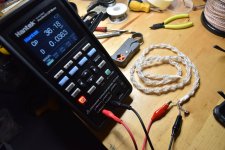
Hybrid SPC/Cu braided 16-core
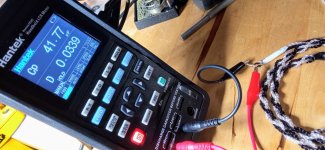
Measuring some vanDamme Silver Series LoCap (55pF/m) cable as a control.
I measured it at 57pF/m but hey, my LCR meter is just a Hantek so who's gonna miss 2pF/m? 😀
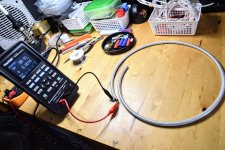
Use DIN connectors where you can. Even better is directly soldering to TT/amp to terminate the connections 😉
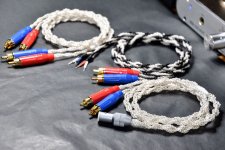
I'm a firm advocate for the CMRR principle which a braided wire geometry facilitates admirably and which provides a better EMI/RFI shield than any built-in cable shield.
I also observed significant and audible differences between SPC, Cu and hybrid SPC/Cu configurations.
The most important thing to remember with phono cables is that shorter is always better as is the lowest capacitance possible in order to create headroom for the higher frequency range in the rest of the signal path.
DIN connectors also have significantly lower capacitance-loading than RCA connectors but the best connection method is direct-soldering to completely mitigate any capacitance increases.
Full SPC braided 16-core

Hybrid SPC/Cu braided 16-core

Measuring some vanDamme Silver Series LoCap (55pF/m) cable as a control.
I measured it at 57pF/m but hey, my LCR meter is just a Hantek so who's gonna miss 2pF/m? 😀

Use DIN connectors where you can. Even better is directly soldering to TT/amp to terminate the connections 😉

Your post got me interested in making cables for my turntable, but I don't know anything about the wires you used. What is full SPC wire, and what is the difference between the full spc and hybrid spc/cu wire? What coating did the wire have? What wire gauge did you use?
Thanks
Thanks
Spc = silver plated copper. It is usually Teflon jacketed MIL spec stuff that I use. You can get it either stranded or single solid conductor. Solid is good inside tube amps but if it’s an interconnect use stranded conductors so it’s easier to bend and route between devices.
I was promised balanced interconnects decades ago, where ae they? At least people are using the cable for it. Balanced would help for phono, but best would be the preamp in the turntable chassis and low-impedance balanced to the amplifier, which could then easily be 50 feet away as the cable flies.
Mini-XLRs FTW!
Mini-XLRs FTW!
I use 49-strand silver plated ofc copper wire in a 4-core braided configuration and then braid 4 separate lengths to get 16-cores. That's the all-silver coloured cable in the photos as the jacket is transparent PVC.Your post got me interested in making cables for my turntable, but I don't know anything about the wires you used. What is full SPC wire, and what is the difference between the full spc and hybrid spc/cu wire? What coating did the wire have? What wire gauge did you use?
Thanks
The 'hybrid' cable I refer to is a 50/50 blend of the SPC wire (2x 4-core lengths) and the same 49-strand configuration but in pure OFC copper (the black strands) and the same 2x 4-core lengths.
It takes a bit of time to braid and prepare as the wire strands are enamelled, so when I have configured them for L/R +/- the individual cores are combined and de-enamelled via solder-dipping.
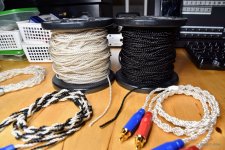
I started using this configuration for headphone cables initially as it's really supple and flexible and has zero microphonics which is important for headphones ofc.
I started looking for a suitable cable to use in a turntable application and tested about 40 different cable types for the lowest capacitance then realised I hadn't measured the overall capacitance of the braided stuff I was using for headphone cables and discovered it was super-low. It was a nice surprise and I only wish I'd have realised before I acquired and tested the other 40 types!
Oh well, I'll never get that time back. But it did reveal a few cable types I use for other applications, so not a complete waste of time.
The same cable as used in a headphone cable application
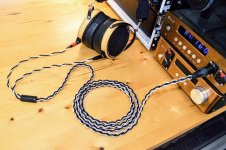
Alpha Audio here in The Netherlands have just conducted an unbelievably deep-dive analysis of 32 different RCA cables (including some of my own) and made some interesting conclusions - the benefits of low capacitance being one of them.
They measured characteristics of cables in the time domain using 2nS pulses which is something I've never seen anyone do before and it was quite revealing to see some of the measurements that distinguish various cables!
Take a look, it's pretty interesting:
Interlinks don’t do anything! Or do they? 32 rca cables analyzed
Silver plated copper measures for lower capacitance than copper. Subsequently, in certain applications, such as for phono cables it can help with reclaiming some overall capacitance loading in a complete signal path between cartridge and your ears.what is the difference between the full spc and hybrid spc/cu wire?
Thanks
Consider that this signal path has multiple connections and different materials, connections and interfaces, all of which add to a cumulative capacitance loading. Any reductions in that signal path can only be beneficial for what ultimately reaches your ears, i.e. crystal clear high frequencies and lower distortion/sibilance above 10kHz.
It's not shown in the photos above, but a full Cu cable in the same 16-core configuration measures around 55pF/m. I don't make these in full Cu as I have a different cable type available for this.
Phono cables are incredibly sensitive to external noise and interference which is why I suggest that the CMRR principle (as implemented via the braid geometry) applies equally as importantly as to whether it is made with SPC or SPC/Cu. For some, mitigating any EMI/RFI interference is as important as good grounding. It also benefits from being zero-microphonic which can mitigate any resonance from contact with other cables/equipment.
Last edited:
Lets see:
At audio frequencies silver plating doesn't get us anything, but it's great at frequencies above 100 megahertz.
Teflon jacketed wire will be silver plated, but with the smaller diameter Teflon insulation the capacitance will be higher and the cable will be more subject to handling noise.
At audio frequencies silver plating doesn't get us anything, but it's great at frequencies above 100 megahertz.
Teflon jacketed wire will be silver plated, but with the smaller diameter Teflon insulation the capacitance will be higher and the cable will be more subject to handling noise.
Silver plating has the added effect on stranded cables of avoiding strand-to-strand copper-oxide conduction. The skin effect is also at high audio, but using thinner gauges reduces this. Copper-to-copper oxide was the first semiconductor diode. High audio does not have much energy so the effect is academical.

Is copper strand oxidation anything but negligible? Maybe with cotton insulation or something 🙂
As always, the proof is in the pudding.Is copper strand oxidation anything but negligible? Maybe with cotton insulation or something 🙂
I have seen cheap PVC insulated copper wire being so oxidized, as to making it impossible to solder. I would not want to use this for phono cart's small analog signal. This application requires very little current so a single strand of any small gauge conductor should do good. Even wire-wrap wire could work. Mechanical integrity dictates most cable constructions.
Depending on the purity of the copper, not only interaction with insulation chloride, some clear speaker cables have been seen with green oxide thru the insulation. There is much written about this subject elsewhere so I will not repeat.
Yes, I believe that it can and does happen in some cases. I am not so sure that it causes measurable signal degradation.
Might depend on what is measured for. It may not be HD/IME that someone should be looking for. Maybe signal correlated noise? IOW, noise floor changes a little with a test signal present. Something like that. Maybe Kind of like measuring Excess Noise in resistors.
Attachments
Rectification of a signal is a problem, as copper to copper oxide forms a rectifier junction, this is something to be aware of.
Cellphone towers are very sensitive to to this, any crappy metal junction near a transmitter can cause Passive InterModulation. PIM levels can obliterate cellphone uplinks, acceptable equipment PIM levels are very low, down in the -150dBm range.
Not exactly audio, but the mechanism is the same.
Cellphone towers are very sensitive to to this, any crappy metal junction near a transmitter can cause Passive InterModulation. PIM levels can obliterate cellphone uplinks, acceptable equipment PIM levels are very low, down in the -150dBm range.
Not exactly audio, but the mechanism is the same.
- Home
- Design & Build
- Construction Tips
- Unbalanced line: your braided/shielded wire and schematic?